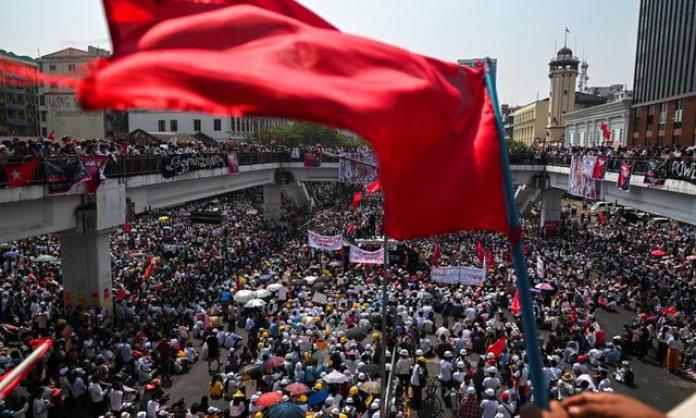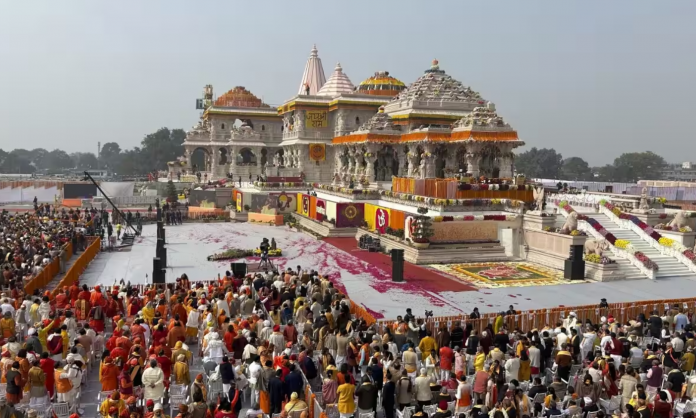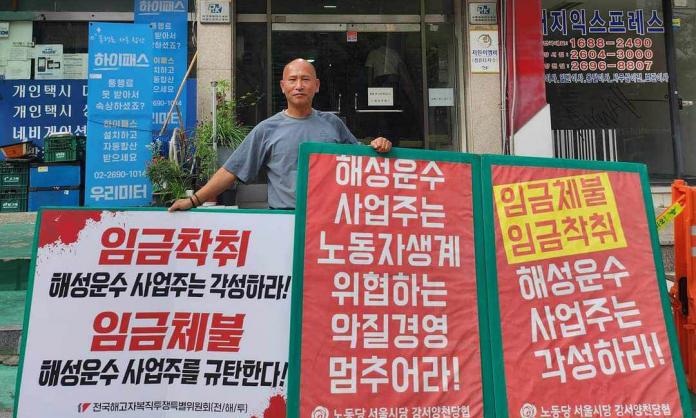In response to a general strike on 22 February, in which more than 1 million people protested across Myanmar, and widespread work-stoppages that paralysed the economy, the Tatmadaw (Myanmar’s military) has unleashed a wave of violence in an attempt to crush the nationwide movement opposed to the new junta.
Police and soldiers have opened fire on crowds of peaceful demonstrators with rubber bullets and live ammunition in several locations across the country. Large deployments of riot police, armed with batons and shields, have charged into crowds in both cities and rural areas, indiscriminately attacking protesters and bystanders. According to the Assistance Association for Political Prisoners, more than 2,100 people have been arrested and more than 200 killed.
Hundreds of thousands of people have marched in funeral processions for the martyrs. In Mandalay, the country’s second-largest city, tens of thousands marched for the funeral of Ma Kya Sin, a 19-year-old woman shot in the head by a sniper after she broke a water pipe so that protesters affected by tear gas could wash their eyes. The following day, tens of thousands of students and workers marched through the city chanting: “We’re not scared because you threaten us with violence!”
At major university campuses, the Tatmadaw have carried out mass arrests of students and staff and established temporary bases for security personnel. Army barracks have now been set up at dozens of campuses. Students at a number of universities have tried to fraternise with rank-and-file soldiers and argue with them to break ranks with their commanding officers.
The scale of the repression has affected the resistance to the junta. The large street demonstrations and open-air assemblies that predominated in the early weeks of the uprising have been replaced with intense street fighting. Protesters and strikers have built barricades out of garbage bins, carts, tyres and barbed wire in working-class districts across Yangon and Mandalay, and major roads in the cities have been permanently blockaded. Protesters have equipped themselves with hard hats, gas masks and makeshift shields to protect themselves during street fighting with security forces.
Importantly, the repression has resulted in strikes expanding into other sections of the working class. Truck drivers and state-run newspaper workers joined the strike movement in response to the heightened repression, pledging to cease work until the military junta is toppled. According to the joint secretary of the Myanmar Container Trucking Association, 90 percent of Yangon’s truck drivers went on strike in the first week of March, promising to deliver only essential food and medicines.
In a major step for working-class resistance, eighteen different union federations and worker organisations issued a joint call for an extended general strike beginning on International Working Women’s Day. Ahead of the general strike, some of the biggest demonstrations in recent weeks were held across the country. Tens of thousands joined mass sit-in protests in Yangon’s Thanlyin township. In Mandalay, thousands of doctors, engineers and teachers marched and pledged to strike indefinitely until the military junta is overthrown.
In an attempt to intimidate workers from joining the general strike, security forces stepped up repression, occupying at least twenty universities, schools and hospitals in Yangon, Mandalay, Magway, Monywa and Ayeyarwady. In the North Oakkalapa township of Yangon, police and soldiers opened fire and used percussion grenades in an effort to intimidate people who had gathered outside a teaching hospital. (Alongside students and universities, the Tatmadaw have targeted health workers and hospitals, because the sector was among the first to resist the military junta and issue the call for strikes and work stoppages last month.)
In defiance of the repression, women workers were on the front lines of the street demonstrations that launched the general strike. Battalions of garment workers waved flags fashioned from htamain (women’s sarongs) and hung them up on barricades while denouncing the Tatmadaw. (The Tatmadaw, deeply superstitious and misogynistic, believe that walking beneath the htamain is bad luck and slows down police and soldiers.)
Mass meetings of garment workers have been reported throughout the industrial districts of Yangon and Mandalay, at which women urged all working-class people to join the extended general strike. In an official statement, the coalition of trade union bodies said: “We call upon all workers to join the extended nationwide strike, and we commit our organisations [to] join in full force”.
Trade unions were officially banned under the previous military junta, which seized power in 1962 and ruled the country until a negotiated transition to civilian rule in 2011. In that year, the ban on trade unions was dropped by the new ruling National League for Democracy (NLD), and collective bargaining legalised. But the NLD, as representative of the liberal sections of Myanmar’s capitalist class, allowed bosses to exploit legal loopholes that left wages unpaid and below minimum-wage standards.
The NLD also used ethnic nationalism and the persecution of minorities, such as the Rohingya, to divert class anger away from economic questions. Despite this, workers have used the expansion of democratic rights, such as the right to form a trade union and to strike, to fight for better wages and conditions.
The female-dominated garment industry has been particularly militant. The garment industry is Myanmar’s chief exporter and employs more than 600,000 workers. A combination of economic and political coercion has forced migrants from ethnic minorities in rural areas into the major cities in search of jobs. Many young women have found work in the garment industry. (Ninety percent of garment workers in Myanmar are women.)
Before the transition to civilian rule, a major strike wave of garment workers swept the country in 2009-10. The strikes were met with fierce coercion: quartering off factories and forcing workers and employers to come to a deal, undercutting the momentum of the movement. But in 2015-17, a wave of wildcat strikes erupted, leading to the creation of new unions. In early 2017, hundreds of workers descended on the Hangzhou Hundred-Tex Garment factory on the outskirts of Yangon, damaging factory vehicles, breaking windows, wrecking machinery, attacking management and taking seven managers hostage. (The riot followed a fifteen-month strike over unpaid overtime that resulted in the factory’s union leader being fired.) Then, in 2019, garment workers led another wave of wildcat strikes before COVID-19 was used to crack down on militancy.
Through struggle, women garment workers have challenged many sexist stereotypes. And unlike countries in which trade unions are well established, with entrenched bureaucracies and passive leaderships, many of the trade unions in Myanmar, such as the Federation of Garment Workers Myanmar, have been established through wildcat strikes and riots. Outright military rule is viewed as an existential threat to the trade union movement that has emerged in recent years. (On 26 February, the Tatmadaw declared most of Myanmar’s trade unions illegal and issued arrest warrants for several trade union leaders.)
Because of their militant history, garment workers have played a decisive role in key moments of the struggle to overthrow the government. They were some of the first sections of the working class to answer the call put out by health workers and students to defy the new junta. In the first fortnight of resistance, they helped galvanise broader layers of the working class behind the strike movement: teachers, civil servants, miners, electricity workers and train drivers.
Now, they are spearheading the general strike. Moe Sandar Myint, leader of the Federation of Garment Workers Myanmar, said during a mass meeting of garment workers in Yangon’s industrial zone of Hlaing Thi Yar: “We are not content simply to create martyrs in the struggle for democracy in Myanmar. We must win this struggle, and the extended nationwide work-stoppage is the path to the people’s victory”.
While the latest general strike represents an advance for the working class, victory is far from guaranteed. The extent to which the strike is observed by non-unionised workers, who form the majority of the workforce, will be crucial. But according to the Confederation of Trade Unions Myanmar, large parts of the economy have been paralysed, including banks, shipyards, transport, railways, major factories, large-scale farms, oil refineries, mines, hospitals, schools, shopping centres and marketplaces. Importantly, all spheres of energy extraction have now ceased, and the country’s fuel and energy reserves are dwindling.
The extended strike poses a series of questions that striking workers will be forced to answer. If the fuel and energy supplies run out, will production be restarted under the control of workers to power working-class districts? If all the farms, food processing plants and marketplaces are shut down, how will working class people feed themselves? Whether workers can access basic necessities while continuing to strike may make or break the anti-coup movement.
The general strike also opens the possibility of splits developing between rank-and-file soldiers in the army and the officers as they are ordered to force striking workers back to work. The overwhelming majority of the Tatmadaw’s infantry are drawn the poor and working class of Myanmar, unlike the ruling cliques of officers and generals who own and control the majority of the country’s productive infrastructure. If soldiers are used to break strikes, the ability of striking workers to present a viable alternative to the leadership of the Tatmadaw will be crucial.
If the extended general strike persists, the Tatmadaw may also try to strike a deal with the NLD and conservative sections of the trade union leadership. But the longer the general strike lasts, the harder it may be for such a deal to be struck. Striking workers will need to defy such concessions if the main demands of the movement—an end to military rule, the release of all political prisoners, a new constitution that removes the Tatmadaw’s influence over political life and a new democratic union that enshrines political rights for all ethnic minorities—are to be won. As the general strike rolls on, the ability of striking workers to answer these questions will be decisive for the movement to topple the military junta.











